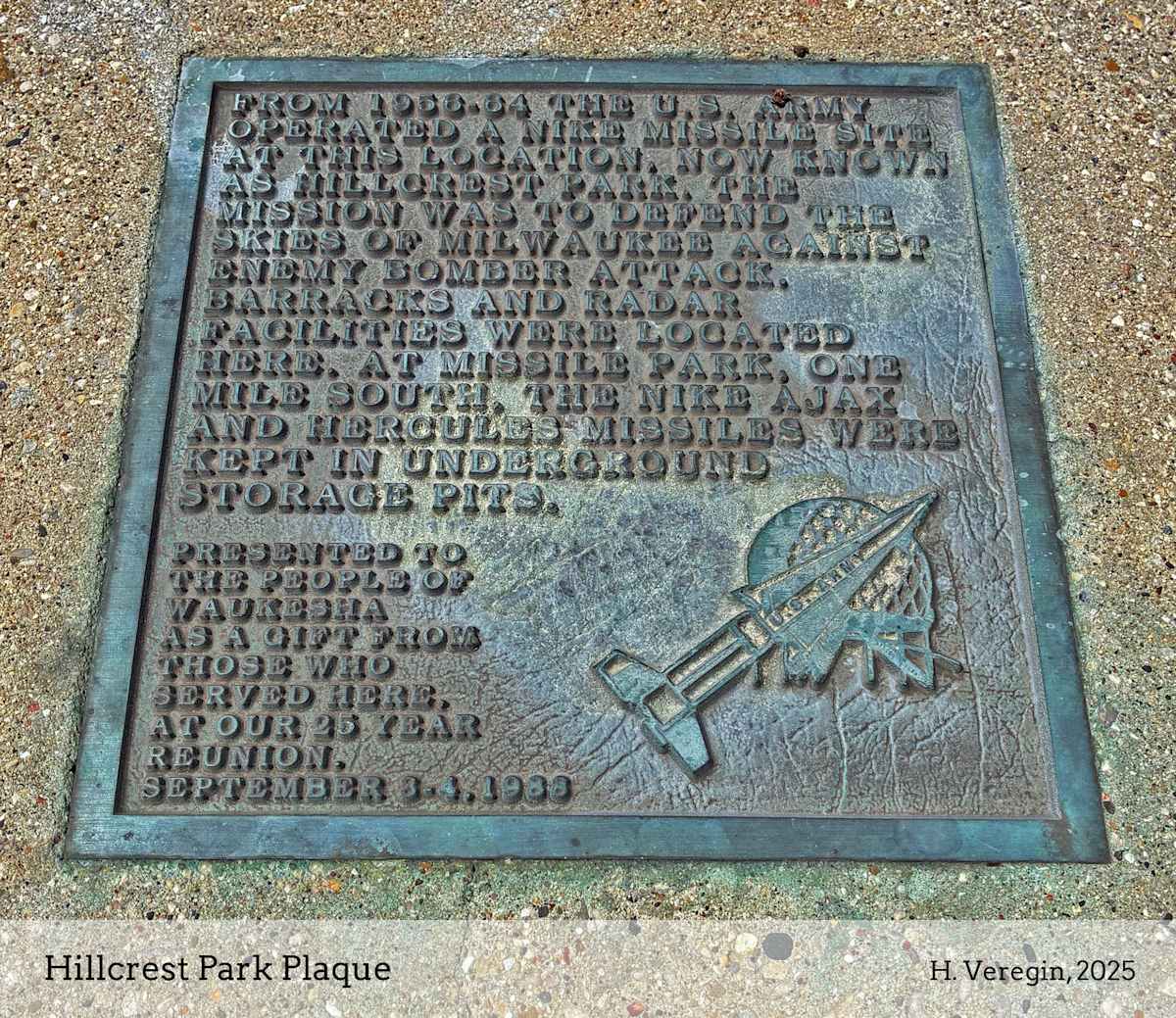Einstein can't be classed as witless
He claimed atoms were the littlest
When you did a bit of splitting-em-ness
Frightened everybody shitless
- Ian Dury, There Ain’t Half Been
Some Clever Bastards, 1978
This is Part 2 in a series about M-74, the Nike nuclear missile site in Waukesha. [Part 1]
The first-generation Nike missile, called Ajax, was 12 inches in diameter and 21 feet in length. It weighed over a ton and carried three high-explosive conventional (non-nuclear) warheads. (A warhead is the explosive part of a missile. The word came into common usage in the 1950s.)
Ajax missiles had two stages. The first stage dropped to the ground after its brief 2.5-second firing, which explains why the launch facility had to be a mile or more from the battery control area. The second stage of the Ajax then burned for over a minute, taking the missile to its target. Ajax was supersonic, attaining speeds of Mach 2.3 (2.3 times the speed of sound or almost 1,700 mph). Almost 14,000 Nike Ajax missiles were built. [1]
The second-generation Nike, called Hercules, could carry a conventional warhead or a nuclear one, which had much greater explosive power and could destroy multiple aircraft at once. Hercules had a ceiling (maximum altitude) of 150,000 feet, compared to 65,000 feet for Ajax. Hercules was also much larger and faster, reaching speeds of Mach 3. In 1958, the Army began replacing the obsolete Ajax missiles with Hercules. Over 25,000 Nike Hercules missiles were eventually built. [1]
Nike missiles were guided to their targets from the battery control area using radar. One radar system tracked the incoming aircraft and fed the results to a computer, which calculated the missile’s trajectory, relaying this information to the missile via another radar. The basic idea was simple – the missile would intercept the target and then detonate, scattering pieces of the missile, enemy airplanes and their cargo (nuclear bombs) across the skies.
The cinder block buildings and metal structures in Hillcrest Park are remnants of the battery control area, where soldiers lived and worked. [2] More soldiers worked at Missile Park. Their job, upon receiving a warning signal from battery control, was to move the missiles from their underground storage silos to their surface firing positions. They were required to demonstrate the ability to launch one missile within fifteen minutes of a warning signal and maintain sustained fire until all missiles were depleted.
The Waukesha Daily Freeman newspaper (later known as just the Waukesha Freeman) recounts the history of the Waukesha M-74 Nike site in a series of articles from the mid-1950s through the late 1970s. Congressman Glenn R. Davis announced in October 1954 that Waukesha would become home to a Nike missile launch site, one of eight planned for the Milwaukee area. Two others were announced for Waukesha County at Menomonee Falls and Muskego. According to Brigadier General T. W. Parker, commander of the 45th anti-aircraft brigade, construction would begin in the spring of 1955. The exact locations were kept secret, not out of national security concerns, but to keep real estate prices from going “sky high.” [3][4][5]
Surveying and soil analysis of sites began in December by the Milwaukee District Corps of Engineers. Sites were selected based on size and location, as well as the need to keep a clear line of site between the battery control and launch areas. A visibility easement was probably established to prevent any obstructions from blocking the view. A safety zone around the installation was also required. [5]
Ironically, on the same day Albert Einstein died (April 18, 1955), Federal Judge Robert E. Tehan of Milwaukee ordered three 60-acre areas in Waukesha County to be sold to the government for a fair market price (to be determined by the government). These three areas were to become the Nike sites in Waukesha County. The order came after the government filed lawsuits to condemn the land. Property owners had little recourse but could file a response in court if they wished. [6]
In May, bids were opened by the Corps of Engineers for the construction of buildings, a mess hall, barracks, underground missile storage silos, parking areas and other structures. Construction was completed in the fall of 1955. [7][8]
Next week, we’ll look at the evolution of M-74 into the 1960s.
Sources:
[1] Department of Defense and Department of the Interior, Last Line of Defense, 1996. Available online at https://ed-thelen.org/pics/LastLineDefense-Illinois.pdf
[2] Hillcrest Park, City of Waukesha. https://www.waukesha-wi.gov/_T10_R125.php
[3] ‘Nike’ Launcher Seen for County, Waukesha Daily Freeman, Oct 9, 1954 (p. 1)
[4] Exact Location of Nike Sites Not Revealed, Waukesha Daily Freeman, Dec 6, 1954 (p. 1)
[5] Signs Point to Nike Site Just East of Waukesha, Waukesha Daily Freeman, Feb 2, 1955 (p. 1)
[6] Court Orders Sale of Nike Sites to Government, Waukesha Daily Freeman, Apr 18, 1955 (p. 1)
[7] Set Dates to Open Nike Bids, Waukesha Daily Freeman, May 11, 1955 (p. 1)
[8] Nike Construction, Waukesha Daily Freeman, June 10, 1955 (p. 2)
